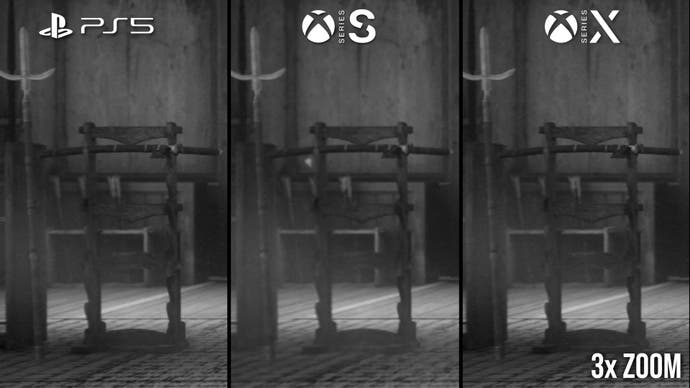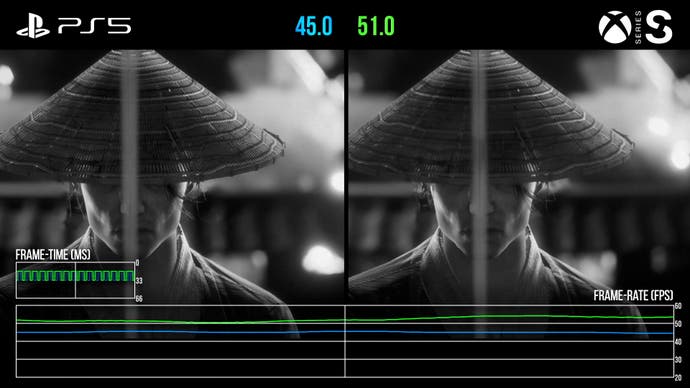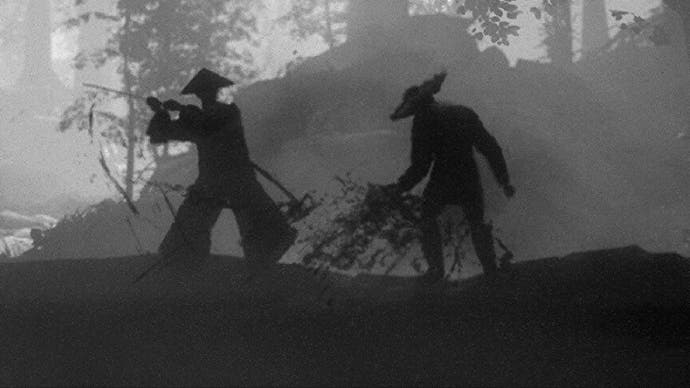Trek to Yomi: stunning aesthetics but performance falls short
PS5 and Xbox Series consoles tested.
Trek To Yomi is a fascinating, extremely stylish release. Its aim is to emulate classic Japanese samurai movies, with Kurosawa and Kobayashi the clear influences. Everything from the letterboxed, monochromatic presentation right down to the film grain and shot framing are clearly inspired by Japanese cinema, with Unreal Engine 4's post-processing pipeline used to render this stylised, cinematic experience. This isn't a massive blockbuster title but there's a deep fidelity to the source material here and a brilliant sense of aesthetics.
There's an immediate sense that the developers have tried to really achieve something special here and that starts with the camera work: most of the game's cinematics use a mix of stationary shots and slower panning shots, typical of early Japanese film. Camera framing takes a lot of inspiration from this work as well; a lot of care has been taken with shot composition, with carefully framed foreground, midfield, and background detail. The camera ends up being quite fundamental to the game itself, and it's semi-fixed during gameplay - there's no direct player control over this element, and most shots simply follow the player's movement by scrolling or panning.
This enables the developers to use a strong and very high quality depth of field effect, even during gameplay. Shallow depth of field is present in virtually every shot here, emulating the long-lens look of Kurosawa films. In a typical game with a right-stick third-person camera, depth of field might obscure critical gameplay elements, but here the focal point of each scene is carefully defined such that this doesn't occur. The relatively sedate camera movement avoids depth of field artefacting as well, which helps particularly on fine transparencies like grass and hair. A heavy film grain is also used here, embellished with scoring marks, bright lines and other artifacts, reminiscent of grain from old film stock.
Trek to Yomi also makes a compelling use of lighting effects to really sell the look of certain shots. Volumetric light shafts are used frequently and characters often appear in silhouette against bright light sources. The attention to detail in lighting here is impressive - fire, for instance, is properly exposed as an older camera would see it and looks very bright. There's a realistic interpretation of the limits of dynamic range, with darker scenes displaying a lot of lost detail in highlights and shadowed regions.
I could go on but the fact is that this is a really special looking game. At its heart it's not tremendously complex - you're mostly engaging in a series of combat encounters, while navigation and progression is very simple. But Unreal Engine 4 is harnessed to create a novel reinterpretation of the styles and techniques that were integral to mid-century Japanese cinema. While a handful of other games have attempted similar visuals - Ghost of Tsushima comes to mind - this goes much further.

Looking at how the console implementations work, we should explain how the game's letterboxing affects resolution numbers. For PS5 and Xbox Series X, the borders encompass 276 pixels above and below the game video - and those borders are never encroached upon, with game HUD elements and subtitles always super-imposed over the central image. The effective viewable resolution of the game is reduced by 552 vertical pixels at 4K, or about 25.6 percent of the screen area that would normally be displayed. This doesn't have an impact on clarity, however - the pixels are still mapped normally. Even factoring this in, pixel counts aren't particularly relevant, such is the level of post-processing. Series S at circa-964p looks similar, but a little blurrier than PS5/Series X's circa-1602p.
All systems get a great-looking game then but performance is problematic as Trek To Yomi runs with an unlocked framerate on all console platforms. On current-gen, we're generally seeing a read-out between 40-60fps in typical gameplay. PS5 and Series X spend a lot of time around 40-55fps - a sort of frame-rate no-man's-land if you will, with constant stutter on a conventional display. Series S, curiously, has a substantial frame-rate advantage, typically leading the more powerful machines by around five frames per second in matching footage. However, none of the consoles feels particularly good to play, exacerbated by the constant lateral movement inherent with a side-scrolling camera. So yes, this is another game - like Elden Ring - that runs at an unacceptable performance level even on the most powerful console hardware available.
That said, there is a variety of tricks that can help, with reasonable solutions for each platform. Firstly, there are two visual options available in the settings menus that can give us a frame-rate boost. Disabling the bloom and grain filters claws back an additional three to six frames per second of performance on current-gen machines, at the cost of some of the game's atmosphere. This is a sort of unofficial 'performance mode' that tangibly improves performance, particularly on Series S, which now hits 60fps much more frequently. Most of the performance gain seems to be coming from removing the bloom lighting effect - the grain filter option has a much smaller impact on performance.

This isn't enough to get a truly stable experience, of course, although it does make things somewhat more bearable. VRR definitely helps too - especially so on Xbox with its wider supported display refresh window. PlayStation 5's 48Hz to 60Hz range does help, but it's not wide enough to encompass the game's lower-performing areas. Far more compelling though is to simply run the PS4 Pro code on PS5 through backwards compatibility. This manages to reach a locked 60fps on PS5, so VRR can be dropped without issue, though resolution takes a dive down to approximately 1920x804. It's a palpably softer game, but the heavy reliance on post-processing dulls the impact of the resolution cut.
This is my preferred way to play the game on consoles though - the steady 60fps provides the sort of consistency that you really want in a timing-based action game like this. On the Xbox side of things VRR does salvage the frame-rate and input issues for the most part on the native Xbox Series games, although obviously, you'll need an appropriate display.
Even though these workarounds are generally effective, this level of performance is not where it should be. The native versions of Trek to Yomi really should be running at a stable 60fps on current-gen machines. It's nice that there are ways we can patch up performance ourselves, but the default version of a game on a standard display should provide a fundamentally sound experience, which we aren't seeing here. And that's a shame as I really enjoyed my time with Trek to Yomi. It's a unique game that exploits modern rendering techniques to create a compelling videogame facsimile of mid-century Japanese movies. Artistically, this is a novel effort and it's well worth checking out - especially if you're subscribed to Xbox Game Pass, where Trek to Yomi is available right now.


